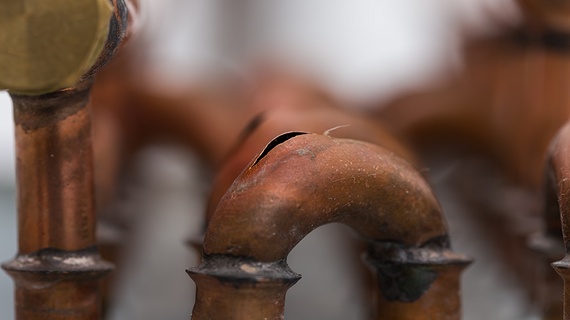
Winter can be a troublesome time for facilities managers of premises with chilled water systems. Once temperatures drop below zero, the water in chilled systems can freeze and cause a decrease in their efficiency, as well as a risk of burst pipes – potentially causing thousands of pounds in damage.
You should take every possible precaution to prevent this from happening. Here’s all you need to know about chilled water system maintenance in the winter.
Why are chilled water systems at risk?
The pipes of chilled water systems are often exposed to low enough ambient temperatures for their water to freeze. If this isn’t kept in check and the frozen water is allowed to expand past the size of the diameter of the pipe, it leads to blockages, leaks and burst pipes. The simplest and easiest way to treat this is to dose the pipe with antifreeze – typically ethylene glycol.
Any premises with a chilled water system may be at risk, although the problem mostly affects chilled systems that have been left unmaintained a while, have been altered or upgraded (which makes it difficult to evidence the quality of the water inside), or have been drained down and topped up again. Some facilities managers or contractors may accidentally contribute to a higher risk by topping up their chilled systems with untreated water, causing the antifreeze to be diluted.
What happens if my glycol levels aren’t correct?
As water begins to freeze in your chilled water system, there’ll be a decrease in flow velocity and your pumps will have to work harder to push water through the pipes. Your energy bills will skyrocket, as will your carbon emissions.
Once the water has frozen solid, the overbearing pressure inside the pipes will cause them to rupture. At this point, the system will fail and you may be forced to close down your premises until the problem is resolved – a catastrophic outcome for many firms, especially retail and hospitality firms in the middle of the holiday season.
The cost of repairing a chilled water system after a failure may reach into the thousands of pounds, even before you consider the damage to your premises caused by leaks. What’s more, the warranty for your equipment may be voided – most manufacturers will discredit their warranties if you fail to maintain the correct levels of glycol in their chilled systems.
Is glycol the only way to prevent freezing?
There are actually three control measures you can use to prevent freezing in your chilled water system:
- Insulation – as the name suggests, this is where insulating material is fitted to the pipework to maintain a consistent temperature.
- Heat tracing – an electrical heating element is fitted to the pipework to regulate the temperature of the water.
- Antifreeze – the water in the chilled system is dosed with glycol or another anti-freezing agent.
Most premises should have at least one of the above control measures in place. For complete protection, however, it’s best to use all three. It’s especially important for premises that rely heavily on a chilled water system, or are at a high risk of freezing, to use an anti-freezing agent.
How much glycol do I need in my chilled water system?
Ethylene glycol is the most common chemical used to combat freezing in chilled water systems. The amount of gycol you need in your chilled system to protect against freezing and burst pipes depends on temperature, so facilities managers (or water treatment professionals do on their behalf) need to make informed judgements on dosing levels based on how low they expect the mercury to drop.
The graph below shows the concentration of glycol required for freeze protection (data from engineeringtoolbox.com):

In the UK, you should protect your chilled water system to temperatures as low as -15° C as a minimum. A professional water treatment company should be able to analyse your glycol levels and advise if a top-up is necessary, as well as carry out the dosing itself as required.
Not sure if you’re protected? Get in touch with Brodex today and we’ll see if we can help. If your site is complex, we may be able to carry out a free site survey to assess your needs before we recommend what you do next.








